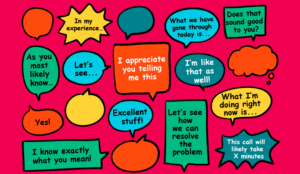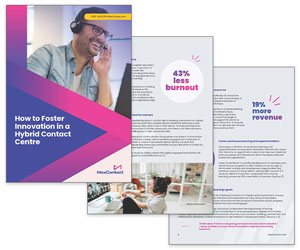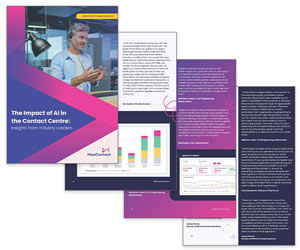It sometimes feels like we live in an angry age. It certainly feels that way to customer-facing staff, who have been subject to a growing torrent of abuse since the start of the pandemic.
In fact, according to the Institute of Customer Service, 60% of customer-facing staff have experienced hostility from customers since early 2020, ranging from shouting and swearing to racial abuse, death threats, spitting and physical attacks. The Institute is running a campaign to highlight the issue.
But it’s not just abuse. Contact centre staff in many sectors are also fielding a growing number of calls from distressed customers who may be struggling to pay bills or meet other commitments.
Research from Forrester in 2021 found that nearly 67% of contact centres were dealing with more complex customer enquiries than a year earlier, and that 70% were facing more calls from “emotionally charged” customers.
Much of this research was carried out during the heat of the pandemic, but with the cost of living crisis in full swing, the situation is unlikely to ease.
With that in mind, we’ve put together six tips to help contact centre staff deal with angry or emotional customers.
6 Ways to Deal With Difficult Customers:
1) Have Clear Processes in Place
In most cases, angry customers can be calmed by an advisor who takes their issue seriously and, if the matter can’t be dealt with there and then, describes a clear path to resolution.
Have guidelines in place for every eventuality and a consistent series of next steps. Make sure your team know them (intelligent scripting can help) and can talk them through with customers. Customers often get frustrated when they can’t see an end to the issue or worry they’ll spend long periods of time in call queues or being passed between departments.
When advisors take ownership of their issue, many customers quickly become calmer.
2) Give Customers Obvious Ways to Complain
It sounds counterintuitive, but making it easy for customers to complain is one way to keep them happy.
Most customers accept that mistakes sometimes happen. Frustrations arise when there’s no obvious way to draw an organisation’s attention to an error or oversight.
Advertise a complaints line and email, and ensure they’re monitored. Customers will appreciate easy ways to report issues, as long as organisations respond promptly and appropriately.
3) Remain Calm and Constructive
However irate a customer gets, team members should stay calm, focusing on what they can do to help. It’s easy to get infuriated with customers who appear to be taking their own frustrations out on a blameless employee, but it’s also counterproductive.
It will probably prolong the call, inflame emotions further and could lead to unnecessary escalation. Unless the customer becomes abusive, stay personable, and emphasise the steps you are taking – or will take – to resolve the problem.
Empathy is crucial here. If the organisation is in error, agents should acknowledge that the customer has a right to be unhappy.
At the same time, advisors shouldn’t have to suffer insults and abuse. Have guidelines in place for them to follow in the event that an emotional caller becomes an insulting or threatening one. For example, some contact centres transfer rude and abusive customers to a recorded message.
4) Differentiate Between Angry Customers and Abusive Ones
We should also reiterate again that customers have a right to complain about poor service or an error that costs them time and energy to resolve.
An angry customer venting about the faulty processes of the organisation is not the same as an abusive one directing anger at an individual agent. Organisations should be able to accept honest criticism and act on it.
5) Offer Callbacks
If a team member can’t resolve an issue during a call, the next best way to defuse a difficult situation is to offer a callback. Advisors may need to involve another department in a customer complaint, or escalate it to a senior manager.
Putting a customer on hold during this process can lead to growing frustration, especially if the wait is longer than a couple of minutes. Offer a callback so the customer can get on with their day while their complaint is dealt with. But if you do offer a callback, you have to honour it, and at the time agreed.
6) Train Your Advisors
It’s a good idea to train your team to deal specifically with difficult calls, but training more generally is even more essential. In a nutshell, the more knowledgeable your team is, the more faith customers will have that they can and will resolve complex issues.
In fact, the kind of good contact centre management practices that help drive efficiency can also help to reduce the number of difficult calls agents have to deal with. For example, fast call answering can take the edge off a customer’s anger.
Answering an email complaint within the advertised time shows you take complaints seriously. Intelligent call routing that gets them to the right person first time cuts out one cause of customer frustration.
In other words, having the tools in place to manage your contact centre effectively also helps to pacify difficult customers. Those tools should include intelligent scripting. Giving agents scripted guidance helps them lead difficult conversations to a satisfactory outcome.
For more information on smart scripting, and templates you can use in your own contact centres for dealing with difficult customers, Download our Ebook Now.
This blog post has been re-published by kind permission of MaxContact – View the Original Article
For more information about MaxContact - visit the MaxContact Website
Call Centre Helper is not responsible for the content of these guest blog posts. The opinions expressed in this article are those of the author, and do not necessarily reflect those of Call Centre Helper.
Author: MaxContact
Published On: 23rd May 2022 - Last modified: 24th May 2022
Read more about - Guest Blogs, MaxContact






 MaxContact is customer engagement software that goes above and beyond to build smarter customer experiences. Our platform is packed with powerful features, accessible for businesses large and small, and ensures organisations can operate compliantly.
MaxContact is customer engagement software that goes above and beyond to build smarter customer experiences. Our platform is packed with powerful features, accessible for businesses large and small, and ensures organisations can operate compliantly. 































